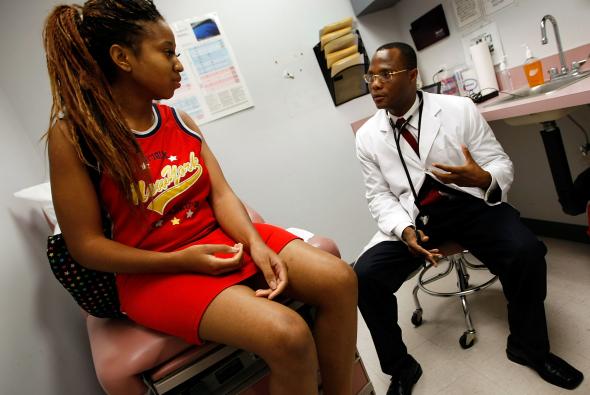Obamacare and the “Young Invincibles”

Photo by Joe Raedle/Getty Images
There were two major takeaways from yesterday's big Obamacare announcement: The first was that more than 8 million people had signed up for insurance through federal and state exchanges. The second was that 28 percent of those people who enrolled via the federal exchange were in the 18–34 bracket, the much-coveted demographic the industry has branded the "young invincibles" because they've typically gone without coverage out of a (highly questionable) belief that they just won't get sick.
As I explained yesterday, it's difficult to look at the 8 million figure and see it as anything but a success; the open enrollment total now sits comfortably above even the original CBO projection of 7 million. Despite all the handwringing and bad press that was caused by healthcare.gov, the White House can now say it didn't just live up to open enrollment expectations, it exceeded them.
The second figure, that 28 percent, is a good deal harder to place on the failure-success spectrum. (The demographic is so important because the young, presumably healthy, are supposed to help offset the costs of older, typically sicker Americans who are also in the same risk pools.) The back-of-the-envelope math that had been used by those following the enrollment figures closely was pretty simple: Young Americans represent about 40 percent of uninsured Americans, so in an ideal world they'd also represent the same chunk of the total Obamacare enrollees. (In the months before the open enrollment period, the White House had suggested they were hoping for that mix as well, or about 2.7 million of the original 7 million projection.)
I don't need advanced math to tell you that 28 percent is less than 40 percent. So by that metric, the White House's Two Ferns-themed youth outreach came up well short, even though the final percentage of young enrollments was about 4 percent higher than it was during the early returns. So just how worried should the White House and its ACA allies be? It's tough to say. We're still waiting on the state-by-state breakdowns, which are actually more important than the national numbers. But in the meantime the New Republic's Jonathan Cohn offers up a noteworthy data point that should offer some degree of comfort to those hoping the law works as planned:
Only company officials know exactly what they were projecting—that’s proprietary information—but one good metric is the signup rate in Massachusetts, in 2007, when that state had open enrollment for its version of the same reforms. According to information provided by Jonathan Gruber, the MIT economist and reform architect, 28.3 percent of Massachusetts enrollees were ages 19 to 34, a comparable age group.
Yes, that’s right: The overall age mix for the Affordable Care Act is virtually the same as the age mix was in Massachusetts. More important, it vindicates the predictions of experts like Gruber who said, all along, that young people would be among the last to sign up. “To get to 28 percent overall, there had to be a lot of young people among the late enrollees,” says Larry Levitt, senior vice president at the Kaiser Family Foundation. “That also bodes well for who is likely to sign up next year.”
That optimism aside, clearly the administration was hoping more young/healthy Americans had signed up during the initial open enrollment period. There's a reason why Obama gave the 8 million figure top billing at yesterday's press conference, and why he blurred the young enrollment figure somewhat by talking about the percentage of enrollees under 35—a group that includes children under the age of 18 who are on their parents' plans—and not the more important 18–34 numbers. For now we'll have to wait and see what impact the young-old breakdown has on premiums.
